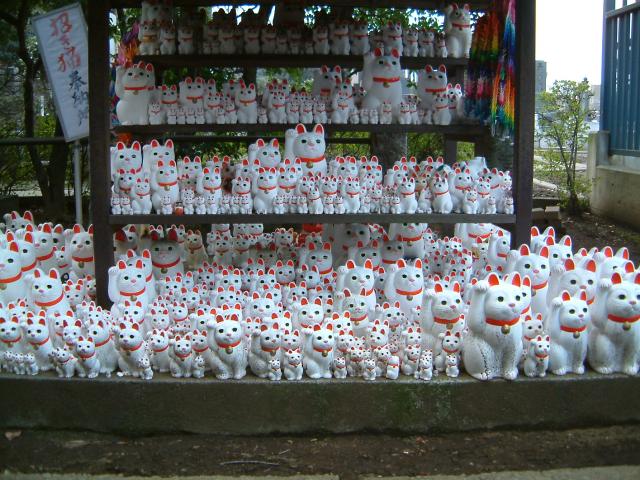Also called "lucky cat", The Maneki Neko is a cat statue traditionally made of ceramic. They are frequently seen at the entrance of restaurants and shops, but also in Japanese houses as a decorative object welcoming visitors.
Where does Maneki Neko come from?
There is a lot of legends around Maneki Neko, but one thing is sure, it comes from Japan. One of them is about a cat named Tama from Gotoku-Ji Temple in Tokyo. According to the legend, in the seventeenth century lived in this temple a monk who, although he had barely enough to live, liked to give some of his food to a cat he was fond of.

One day the monk asked the cat to bring him good luck and shortly after he received the visit of samurai, one of them turned out to be the local lord. He offered them a cup of tea, and the guests began to talk about how they end up here. They said that caught in the storm they stopped and sheltered under a tree, then they saw a cat who was waving to them at the entrance of the temple. Intrigued, they came closer to see it when suddenly lightning fell on the tree where they were sheltered previously. Desiring to thank the cat for saving his life and considering it as the will of Buddha, the Lord offered the monk lands around the temple. This is how the temple acquired its present size. A few years later, the cat died and an altar was built above his sepulture. He was recorded as the deity Shobyo Kannon, the god of mercy.
Today, the Maneki Neko of Gotoku-Ji Temple is characterized by the presence of a necklace and a painted bell representing the monk's love for his cat. Unlike other Maneki Neko, this one does not hold a coin in its paw because it just offers the opportunity to succeed, but it's up to us to seize it.
Which Maneki Neko is made for you?
The characteristics of a Maneki Neko are very important because they affect the benefits it provides. Indeed, these benefits will vary depending on the leg raised, on the color and finally on the paw elevation.
There are two possibilities for the raised leg. If it's the one on the right, it will bring money and if it's the one on the left, it will symbolize the invitation and welcoming. According to the height, the meaning changes. The higher the leg is, the more it will apport good fortune. The Maneki Neko with both legs raised did not exist before, it is due to the modernization of them.

Regarding the colors of Maneki Neko, the most classic one is the tricolor. In cats, this color is almost exclusive to females and is unique to find it in males with a 1/100 probability. That is why, given its rarity, it was elevated to the rank of a lucky charm. The other 3 most common colors are white, black and red. White brings luck. Black is a symbol of luck and an amulet against wicked spirits. Indeed, contrary to Western cultures, in Japanese culture black is considered to possess magical powers to ward off danger. Finally, red helps to ward off diseases. Indeed, in Japanese culture, red is considered hated by the god of measles and variola. There are other less common colors like yellow, gold, pink, blue and green. Yellow and gold ensure your prosperity, the rose increases the chance in love, the blue increases the academic success and the green brings you security at home and during your travels.
There is bound to be a Maneki Neko made for you who will keep you company and bring you luck !!!


